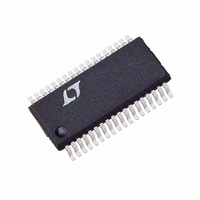LTC1759CG#TRPBF Linear Technology, LTC1759CG#TRPBF Datasheet - Page 11

LTC1759CG#TRPBF
Manufacturer Part Number
LTC1759CG#TRPBF
Description
IC SMART BATTERY CHARGER 36SSOP
Manufacturer
Linear Technology
Datasheet
1.LTC1759CGPBF.pdf
(28 pages)
Specifications of LTC1759CG#TRPBF
Function
Charge Management
Battery Type
Smart Batteries
Voltage - Supply
11 V ~ 24 V
Operating Temperature
0°C ~ 70°C
Mounting Type
Surface Mount
Package / Case
36-SSOP (0.200", 5.30mm Width)
Lead Free Status / RoHS Status
Lead free / RoHS Compliant
Available stocks
Company
Part Number
Manufacturer
Quantity
Price
OPERATIO
Overview (Refer to Block Diagram and Figure 10)
The LTC1759 is composed of a battery charger section, a
charger controller, two 10-bit DACs to control charger
parameters, a thermistor decoder, limit decoder and an
SMBus controller block. If no battery is present, the
thermistor decoder indicates a THERM_OR condition and
charging is disabled by the charger controller (CHGEN =
Low). Charging will also be disabled if AC_PRESENT is
low, or the battery thermistor is decoded as THERM_HOT.
If a battery is inserted or AC power is connected, the
battery will be charged with an 80mA “wake-up” current.
The wake-up current is discontinued after three minutes
if the thermistor is decoded as THERM_UR or
THERM_COLD, and the battery or host doesn’t transmit
charging commands.
The SMBus controller block receives ChargingCurrent()
and ChargingVoltage() commands via the SMBus. If
ChargingCurrent() and ChargingVoltage() command pairs
are received within a three-minute interval, the values are
stored in the current and voltage DACs and the charger
controller asserts the CHGEN line if the decoded ther-
mistor value will allow charging to commence.
ChargingCurrent () and ChargingVoltage() values are com-
pared against limits programmed by the limit decoder
block; if the commands exceed the programmed limits
these limits are substituted and overrange flags are set.
The charger controller will assert INTB whenever a status
change is detected. The host may query the charger, via
the SMBus, to obtain ChargerStatus() information. INTB
will be deasserted upon a successful read of
ChargerStatus() or a successful Alert Response Address
(ARA) request.
Battery Charger Section
The LTC1759 is synchronous current mode PWM step-
down (Buck) switcher. The battery DC charging current is
programmed with a current DAC via the SMBus interface.
Amplifier CA1 converts the charging current through
R
R
pares the output of CA1 with the programmed current and
drives the PWM loop to force them to be equal. High DC
SENSE
SENSE
/R
to a much lower current I
S2
) fed into the PROG pin. Amplifier CA2 com-
U
PROG
(I
PROG
= I
BAT
•
accuracy is achieved with averaging capacitor C
Note that I
generates a ramp signal that is fed to the PWM control
comparator C1 through buffer B1 and level shift resistors
forming the current mode inner loop. The BOOST pin
supplies the top power switch gate drive. The LTC1759
generates a 8.9V V
V
BOOSTC pin supplies the current amplifier CA1 with a
voltage higher than V
Amplifier VA reduces the charging current when the bat-
tery voltage reaches the set voltage programmed by the
VDAC and the 2.465V reference voltage.
The amplifier CL1 monitors and limits the input current,
normally from the AC adapter, to a preset level (92mV/
R
ming current I
current.
The INFET pin drives an external input P-channel FET for
low dropout applications.
SMBus Interface
All communications over the SMBus are interpreted by the
SMBus controller block. The SMBus controller is an
SMBus slave device. All internal LTC1759 registers may
be updated and accessed through the SMBus controller,
and charger controller as required. The SMBus protocol is
a derivative of the I
to Use It, V1.0” by Philips and “System Management Bus
Specification” by the Smart Battery System Organiza-
tion*, for a complete description of the bus protocol
requirements.)
All data is clocked into the shift register on the rising edge
of SCL. All data is clocked out of the shift register on the
falling edge of SCL. Detection of an SMBus Stop condition,
or power-on reset via the V
reset the controller to an initial state at any time.
The LTC1759 command set is interpreted by the SMBus
controller and passed onto the charger controller block as
control signals or updates to internal registers.
I
*http://www. SBS-FORUM.org
2
C is a trademark of Philips Electronics N.V.
BOOSTC
CL
). At input current limit, CL1 will supply the program-
as well as to drive the bottom power FET. The
PROG
PROG
has both AC and DC components. I
2
C
GBIAS
TM
and thus reduce battery charging
CC
bus (Reference “I
for bootstrapping V
for low dropout applications.
DD
undervoltage lockout, will
2
C-Bus and How
LTC1759
BOOST
11
PROG
PROG
and
.














